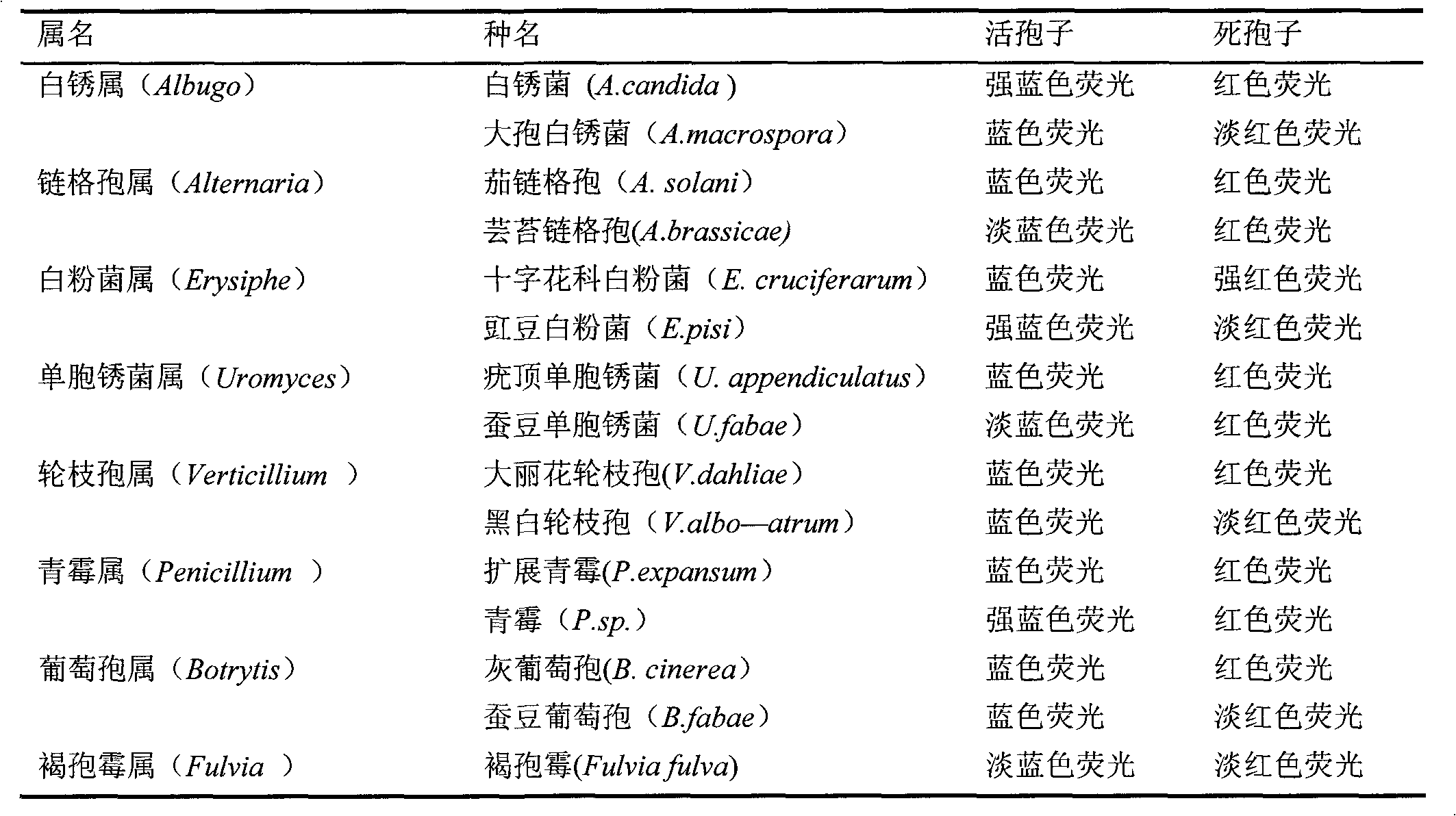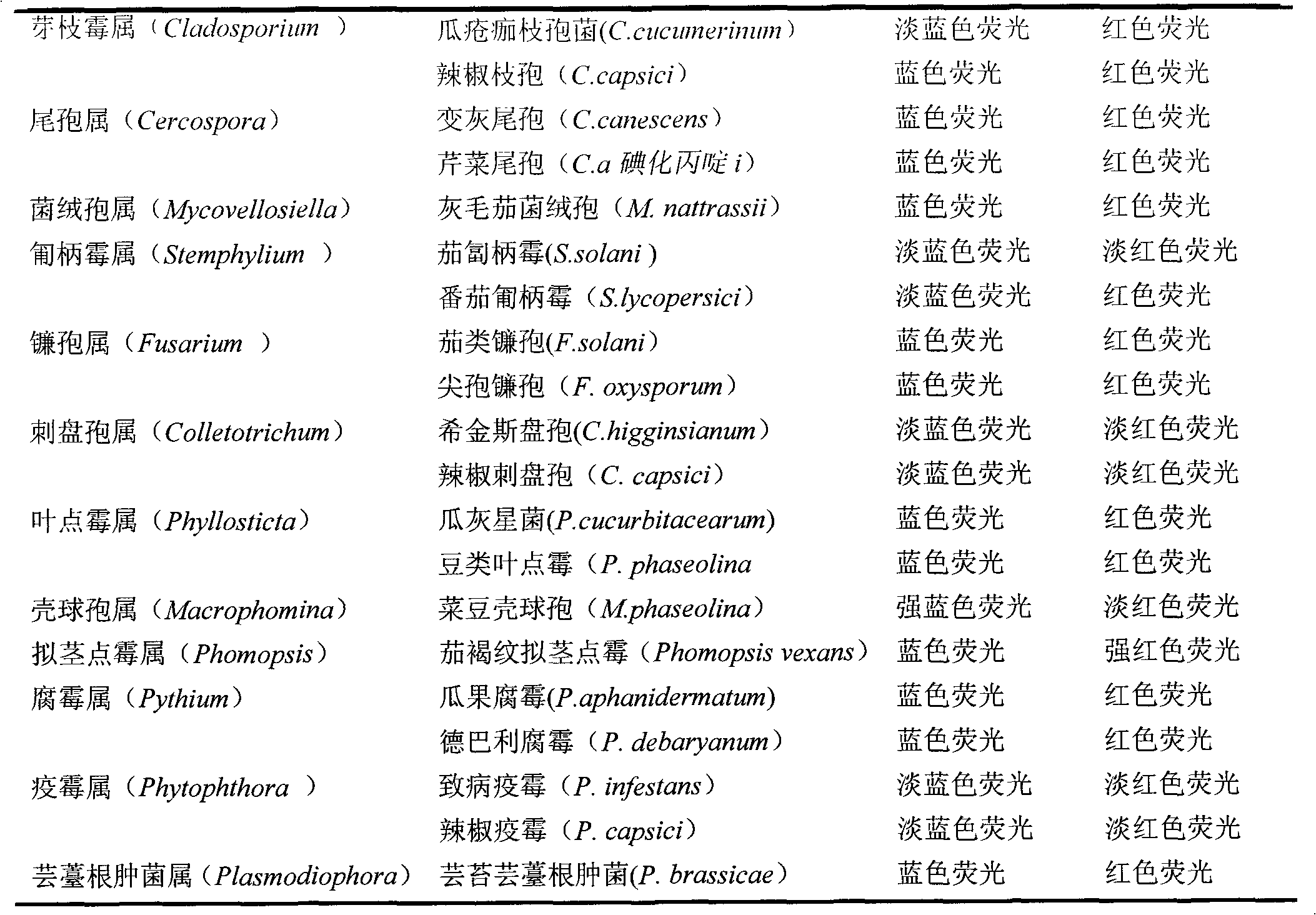Method for detecting activity of spores of plant pathogenic fungi and plasmodiophora brassicae
A technology for plant pathogenic fungi and Brassica rhizogenes, which is applied in material excitation analysis, fluorescence/phosphorescence, etc., can solve the problems of high toxicity of dyes, toxicity of detection time and detection process, unstable detection results, etc., and achieves good repeatability. Effect
- Summary
- Abstract
- Description
- Claims
- Application Information
AI Technical Summary
Problems solved by technology
Method used
Image
Examples
Embodiment 1
[0020] Example 1: Detection of spore activity of plant pathogenic fungi and Plasmodium brassicae
[0021] 1. Materials and instruments
[0022] Hoechst33342 (SIGMA), propidium iodide (SIGMA), Olympus fluorescence microscope (DP72).
[0023] 2. Experimental method
[0024] Part of the phytopathogenic fungal spores were used as materials (Table 1), and the Hoechst33342 / propidium iodide double staining method was used to identify the dead and alive phytopathogenic fungal spores. Add 1 μl of Hoechst33342 (dissolved in PBS) with an initial concentration of 100 μg / ml to 99 μl of spore suspension, mix well, and incubate at 37°C for 10 minutes, centrifuge at 1000 r / min at 4°C, add 100 μl of sterilized Wash once with distilled water, centrifuge to remove the supernatant, add 100 μl of sterilized distilled water to resuspend, then add 500 μg / ml propidium iodide staining solution (dissolved in PBS) and mix with the spore suspension, the final concentration is 5 μg / ml, 4 Stain in the d...
Embodiment 2
[0030] Example 2: Hoechst33342 / propidium iodide staining concentration and time screening
[0031] 1. Materials and instruments
[0032] Fusarium oxysporum strain HG504281, Plasmodium brassicae strain DBC11071501, Hoechst33342 (SIGMA), propidium iodide (SIGMA), Olympus fluorescence microscope (DP72), electric thermostatic water bath (XMTD-700).
[0033] 2. Experimental method
[0034] Using P.brassicae and F.oxysporum as experimental materials, the concentration and staining time of Hoechst33342 and propidium iodide dyes were screened. Freshly prepared spore suspensions were divided into two groups: one group was untreated living spores used for germination experiments as a germination test control (group K); one group was untreated living spores used for staining experiments (UK group) ). Concentration gradient experiments with 4 different dye concentrations were designed for two dyes: stock solution 100 μg / ml, 10-fold dilution 10 μg / ml, 20-fold dilution 5 μg / ml, 50-fold d...
Embodiment 3
[0038] Combined with the effect of staining on spore activity, and the effect of fluorescent microscope observation on the distinction between dead and alive spores after staining, the staining condition that does not affect spore activity and has the best staining effect is selected: Hoechst33342100 times dilution, the corresponding dye concentration is 1 μg / ml, staining The time is to incubate at 37°C for 10 minutes, centrifuge at 4°C to remove the dye, dilute propidium iodide 20 times, the corresponding dye concentration is 5 μg / ml, and the staining time is 15 minutes. Embodiment 3: Physically treated (heat treated) Plasmodium brassica spore activity detection and quantitative analysis 1, materials and instruments
[0039] Plasmodium brassicae strain DBC11071501, Hoechst33342 (SIGMA), propidium iodide (SIGMA), Olympus fluorescence microscope (DP72), electric thermostatic water bath (XMTD-700). 2. Experimental method
[0040] Plasmodium brassicae was used as the experimenta...
PUM
 Login to View More
Login to View More Abstract
Description
Claims
Application Information
 Login to View More
Login to View More - R&D
- Intellectual Property
- Life Sciences
- Materials
- Tech Scout
- Unparalleled Data Quality
- Higher Quality Content
- 60% Fewer Hallucinations
Browse by: Latest US Patents, China's latest patents, Technical Efficacy Thesaurus, Application Domain, Technology Topic, Popular Technical Reports.
© 2025 PatSnap. All rights reserved.Legal|Privacy policy|Modern Slavery Act Transparency Statement|Sitemap|About US| Contact US: help@patsnap.com



